#flour war
Explore tagged Tumblr posts
Note
In your post on 10 August you correctly pointed out how often the violence under the Ancien Régime gets always overlooked and you mentioned the Beast of Gévaudan, the deliberate repressions by Louis XIV or Louis XVI, the repression of the Flour War. What happened during these events?
Warning: Regarding the case of the Beast of Gévaudan, there are some shocking elements related to the criminal investigation. So, please refrain from reading if you feel uncomfortable with this. Sensitive souls should refrain from reading this part of text. I want to mention that I am not very knowledgeable about the Ancien Régime, so feel free to correct or add to what I say (especially regarding the Flour War).

Dragonnades under the reign of Louis XIV to force Protestants to convert to Catholicism ( The engraving dates from 1686 and is by Engelmann, Les nouveaux missionnaires)
Ah, here we are again, discussing the Ancien Régime. There are many things to say (some of which are positive; we should also fight against the demonization, but I will limit myself to starting with the period under Louis XIV rather than Henri IV).
Louis XIV, what can be said? Well, ironically, if we want to better study the issues that led to the Revolution, it starts with him (in my eyes). I will quickly touch upon his reign and the reasons why he wanted an absolute regime (due to the trauma he experienced as a child during the trials he endured during the Fronde, under the regency of his mother and Cardinal Mazarin). One day, I came across a phrase on a forum that I found revealing about the reigns of Louis XIV, Louis XV, and Louis XVI. It said something like, "Louis XIV creates the debt, Louis XV manages it and passes it on to his successor (Louis XVI), who, due to his character and actions, causes the Revolution to break out." Although reality is more complex, I think this phrase aptly describes the origin of the massive debt of the Kingdom of France.
His wars financially drained the kingdom of France, showing that, in reality, wars of conquest can be more harmful than beneficial due to their expenses, especially if the territories do not bring in revenue (at least when Tsar Peter the Great waged war against the Turks, it was to gain access to the Sea of Azov for long-term commercial purposes). By the end of his reign, the state was financially ruined, all due to excessive conquests and wars that could have been avoided. Let's not even talk about horrific episodes like the Sack of the Palatinate in 1689 and how he alienated foreign powers. Here’s what Voltaire had to say on the subject: "This beautiful country was ravaged under Louis XIV for the second time; but the flames with which Turenne had burned two towns and twenty villages in the Palatinate were mere sparks compared to this final conflagration. Europe was horrified. The officers who carried it out were ashamed to be the instruments of such cruelties" (excerpt from The Age of Louis XIV).
This led to several revolts due to the increasing tax burden, the most notable of which was in Brittany. It is important to note something about Brittany and taxes. In 1491, Duchess Anne of Brittany married Charles VIII. France then annexed the Duchy of Brittany, but in return, Brittany retained a fiscal system specific to the former duchy, and no additional levies could be imposed without the agreement of this former duchy.
Louis XIV violated this fiscal exception and increased taxes as part of his war against Holland. This led to what would be called the Revolt of the Red Bonnets in Brittany, and across France (as there were other zones of insurrection like Grenoble, Bordeaux, Pau, Besançon), it would be known as the Stamp Paper Revolt in 1675, triggered by the ever-growing misery of the population. The revolt in Brittany was the most significant, with castles being attacked and uprisings against their lords. On July 2, the rebels demanded the abolition of seigneurial abuses, among other things, and proclaimed a Peasant Code, which included a series of texts, some of which apparently echoed aspects of the grievance lists of 1789.
The repression in Brittany was brutal. Six thousand men were sent to crush the rebellion. There were hangings, and some were sent to the galleys. The body of one of the leaders, Le Balp, was exhumed to be desecrated. Other leaders were tortured before being executed. The suburb of Saint-Malo was deemed too rebellious.
In October 1675, the city experienced violence, apparently at the hands of Louis XIV’s troops. Residents of certain streets were expelled to the point where the Marquise de Sévigné wrote, "Do you want to know the news from Rennes? An entire large street was driven out and banished, with the threat of death if they were taken in, so that one could see all these miserable people—old men, women who had just given birth, children—wandering in tears as they left the city." On February 5, 1796,
In his absolute control, Louis XIV sought to annihilate any rebellion. Under Louis XIV, there were 40,000 deserters, Protestants, counterfeiters, and salt smugglers condemned to the galleys, which was a horrific ordeal.
For criticizing absolutism, the theologian and tutor of the king’s grandson, Fénelon, fell out of favor. To better eliminate any opposition, a new position of Lieutenant General of Police was created in Paris, tasked with not only surveillance but also reforming justice to extend cases that could be judged directly by the King’s judges. During the inquisitorial process, the investigation was secret (which, as a law student, I admit can have both positive and negative aspects) and confessions were extracted, including through the use of torture (terrifying and horrible).
The Code Noir of 1685 authorized and even justified slavery with the goal of increasing the production of mineral and agricultural wealth.
The Edict of Nantes, which had allowed Protestants to live in peace, was revoked by Louis XIV. This led to the "dragonnades," a method in which "dragons," or royal soldiers, were forcibly quartered in the homes of Protestants considered heretics, using all possible means to force them to convert. I can hardly imagine the brutalities committed in the homes of these victims to obtain so many abjurations from the Protestants so that these soldiers would leave.
When Louis XIV died, he was deeply unpopular. Misery was widespread, and the peasant class could barely survive. In the event of climatic accidents, famine and mortality rates were extremely high, particularly in 1694 and 1709.
It is easy to see that the seeds of the Revolution were already being sown under Louis XIV. In 1694, there was the Red Bonnets uprising, and barely a century later, the Revolution and the overthrow of the monarchy, and the uprising of the slaves. We can clearly see where the first seeds of the Revolution began to germinate.

The fight of Marie-Jeanne Vallet, known as the “Maid of Gévaudan”, against the beast. Sculpture by Philippe Kaeppelin.
Now we come to the case of Louis XV, and one example that struck me the most about the dysfunction of the country is the affair of the Beast of Gévaudan (though there are many others, and more important ones). This remains one of the most mysterious criminal cases that has never been solved. However, this example highlights another dysfunction of the Ancien Régime beyond slavery, famine, religious intolerance, and repression. It is simply the issue of security in the face of the crime that the lower class suffers in certain areas.
France had just come out of the Seven Years’ War (an extremely deadly conflict), relatively defeated by England and financially ruined. The incident took place in the county of Gévaudan (which is in the province of Languedoc). The area included the Margeride, a difficult-to-access region with mountain ranges and marshes. In Gévaudan, life was harsh, predominantly populated by peasants; life was very tough, life expectancy was very short, children started working very early, and the peasant class primarily sought to survive.
But it’s the problem of crime that will be highlighted here (so I won’t go into too much detail about the affair of the Beast of Gévaudan). However, it’s necessary to explain this criminal case to better understand what follows. This case is complex, and the aim is not to explain it fully but rather to show the attitude of King Louis XV’s government, which tends to indicate what could be called willful criminal negligence. Therefore, the mystery of the Beast of Gévaudan is quickly summarized, and if you’re interested in understanding the case from an "investigative" perspective, you won’t find it here (it would take at least two to three pages), especially for suspects and theories explaining this mystery.
It all began in June 1764. A shepherdess living in Langogne was attacked by a beast. She owed her life to the cows that charged to protect their calves. The most striking thing is that the beast completely ignored the cows to focus solely on her. She survived, but it was the beginning of a long series of attacks. The beast was described as a wolf with a black stripe down its back (even today, it’s unclear whether it was a dog or a wolf). This was surprising because the inhabitants were always close to wolves, and no attacks had been recorded.
The beast went on to claim several victims, some of whom were horrifically devoured alive in front of helpless witnesses. Some survivors were scarred for life, and several children died.
Initially, King Louis XV took the matter very seriously: he sent one of his close associates, François Antoine, and enormous resources were employed. However, when the beast was not conspicuously absent, bullets seemed to bounce off it, or it got back up (one of the reasons for speculating that the beast had been trained by a human, as the black stripe could have come from a boar’s hide used as a protective cuirass against pistol bullets). Very questionable means (to put it mildly) will be used such as poisoning the corpses so that the Beast of Gévaudan eats it and poisons itself. But it doesn't work. Then, on September 20, 1765, François Antoine (or one of his aides) killed the beast. Witnesses and survivors of the attacks confirmed it was the Beast of Gévaudan (about twenty of them). However, it had killed on the other side of the river, where it had not been very active. Despite this, Louis XV declared that the affair was over and that the Beast of Gévaudan had been killed. And yet, after a period of calm due to the winter (when herds were less exposed), the attacks resumed with even greater intensity in the spring, with more and more victims. The attacks were concentrated mainly in the Margeride.
This is where we see the indifferent side of the Ancien Régime. For the monarchy, which had been ridiculed by the Beast of Gévaudan, the matter was closed. Officially, the Beast of Gévaudan had been killed, and with censorship in place, there was no mention of other attacks by the beast after 1765. On gravestones, it was now forbidden to say that a victim had been killed by the Beast of Gévaudan. There would be no more assistance, and the inhabitants were left to fend for themselves. One must be cautious, but we can speak of willful criminal negligence: to save face, the monarchy pretended to ignore the deadly attacks and even censored news about the affair. Fortunately, the Marquis d’Apcher continued to organize hunts to kill the beast at his own expense. But his resources were not those of a state and therefore very limited. The attacks officially ended in June 1767. A man named Jean Chastel ended the Beast’s life under strange circumstances (I don’t want to accuse deceased people with little evidence; it’s just that some facts make him seem suspicious, while others exonerate him, especially since in those superstitious times, he was looked down upon for reasons we’d find foolish today. For example, he apparently didn’t attend church much, although when Marie Danty, a 12-year-old girl with whom he was friendly, was devoured alive, he began attending church and had his bullets blessed. He could read and write, which was rare for someone of the lower class, and he was allegedly the son of a healer, whom some called a witch. On the other hand, when Marie Danty died, he swore he would be the one to kill the Beast of Gévaudan, and according to some witnesses, when the beast saw him, it simply sat down, whereas when it was present, it wouldn’t let itself be caught. Moreover, its black stripe had disappeared, although survivors had said it had one. However, I ask that we avoid making accusations against Jean Chastel out of respect for his descendants,while there is a high probability that he is innocent , we cannot make accusations without evidence).
Another frightening aspect of France in this affair is that not all the crimes were committed by the Beast of Gévaudan. It’s clear that at least several murderers committed acts that were blamed on the Beast, especially considering how some victims were killed. In fact, Margeride was notorious for its lack of security, its criminality, and the maréchaussée (mounted police) had only just been established, with many brigands or worse. The last crime attributed to the Beast of Gévaudan was actually committed by a human who killed a woman, Marianne Thomas, in 1777. The woman, in her agony, said it was the Beast. But in reality, it was a man disguised as the Beast, wearing fur, who had committed the crime. So, in addition to famine, it seems that the Ancien Régime either did not want to or failed to ensure that the maréchaussée was effective in protecting the lower class.
Another negative aspect of Louis XV’s regime was the continued religious fanaticism. During the attacks of the Beast of Gévaudan, some believed the beast was the result of divine punishment for the inhabitants’ sins (another theory said that the beast of Gévaudan was suckling a werewolf and that silver bullets were needed to kill it) . There was the infamous case of Calas, where a father was tortured to death because he was Protestant, accused on very doubtful, if not nonexistent, evidence. Then there was the affair of the Chevalier de la Barre, in which a young nobleman was tortured and executed for the crime of blasphemy (desecration of a crucifix) and it seems that it was not sure if it was him who did that, not to mention the sect of the White Penitents in Toulouse, who were a model of intolerance at that time. Additionally, the Church owned at one point 6% of the land in the Kingdom of France and profited from it, while the state coffers did not benefit. Not to mention other legitimate criticisms that could be made against the Church.

Anne Robert Jacques Turgot (French school, Palace of Versailles) (1727-1781)
Finally, here is the Flour War under Louis XVI. Ironically, the minister at the heart of these events was the most competent of Louis XVI’s ministers. Turgot is considered, in a way, a reformer (in fact, part of the nobility hated him for this), but also a liberal. There was much speculation because the monarchy was stockpiling grain. Turgot instead decided to impose the free circulation of grain. However, the poor harvests of 1773 and 1774 led to a significant increase in prices. This further deepened the misery of the peasants, as bread was their staple food. Consequently, riots broke out, with bakeries being looted and grain stocks seized. In response, 25,000 soldiers were deployed, leading to 548 arrests and the execution by hanging of two rioters: a 28-year-old wigmaker and a 16-year-old boy guilty of kicking a bakery door. The execution of these two scapegoats shocked the crowd.
So, my opinion on Turgot is that he was one of Louis XVI’s most competent ministers and the one who, among all his successors, had the people’s best interests at heart. But he was neither a political genius nor an engaged man like the revolutionaries who would take over after the Ancien Régime (at least many of them). I’m going to deliberately provoke by saying that if he was in the most committed political class concerning the Absolute Monarchy, he would likely have been on the far right during the French Revolution (though less conservative than Necker, for sure). But I’m probably being unfair because he died before we could know what he would have done, knowing that he didn’t play a false role as a friend of the people like Necker did, but rather acted more in favor of reforms, unlike the latter.
However, I must point out, in defense of Louis XV and Louis XVI, that absolutism had its limits in the form of the Parliaments, and they had to delegate certain powers to the Parliament. Yet, the Parliament opposed some necessary reforms for the people to ensure that the nobility could maintain its privileges while pretending to be friends of the poor people (we can clearly see where Necker learned this attitude).
P.S: I didn't mention the repression following the Reveillon affair, due to the events of April 26 to April 28, 1789 as it wasn't ask.
Sources: Antoine Resche For the Beast of Gévaudan: YouTuber Lionel Camy, who is very knowledgeable about criminal cases he explains. His video on the Beast of Gévaudan was excellent.But that does not prevent us from seeing historians given that Lionel Camy is more specialized in the analysis and theories of crime. Thierry Aprile
24 notes
·
View notes
Text

x
#flour war#2014#photography#black and white#black and white photography#action shot#action photography
3 notes
·
View notes
Text

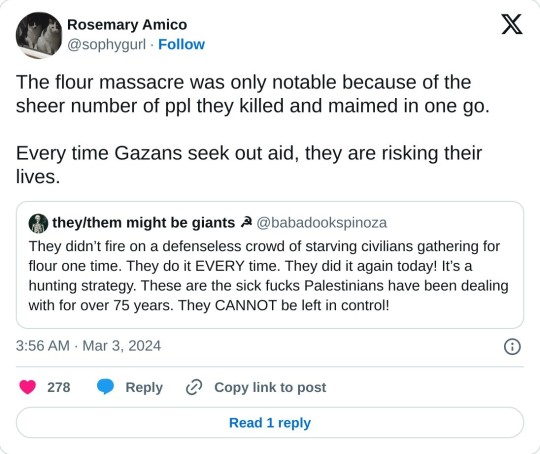
OP isn't exaggerating. There are countless of videos of the IDF shooting at crowds of Palestinians trying to find food for themselves and their starving families. The UN World Food Programme even suspended delivering aid because the IDF won't stop shooting people.




#yemen#jerusalem#tel aviv#current events#palestine#free palestine#gaza#free gaza#news on gaza#palestine news#news update#war news#war on gaza#flour massacre#genocide joe#gaza genocide#genocide#long post
28K notes
·
View notes
Text


Sen. Bernie Sanders (I-Vt.) is pushing harder for a cease-fire in Gaza and demands that the United States send “not another nickel” to Israeli Prime Minister Benjamin Netanyahu.
“My view, not another nickel for Netanyahu’s government if he’s going to continue this wholesale slaughter of the Palestinian people,” Sanders told MSNBC’s Alex Wagner Friday.
Sanders’ declaration comes just days after the death toll in Gaza surpassed 30,000 people since the start of the war on Oct. 7, according to the Palestinian Health Ministry. More than 100 Palestinians in Gaza City were killed and more than 700 injured Thursday, when Israeli soldiers opened fire on the people scrambling to access humanitarian aid, some media outlets reported.
Sanders, who recently voted against sending more aid to Israel for its war against Hamas, stressed the importance of stopping the “unprecedented humanitarian disaster.”
The Vermont senator argued that President Biden, who has put pressure on Netanyahu and Israel to scale back its attacks, is taking “an important step forward,” but argues that “we need to do more.” Biden said Friday that the U.S. will begin airdrops of aid to Gaza amid negotiations for a cease-fire.
Sanders said Biden should be telling the Israeli government to open borders so trucks of food, water and medical supplies that are critical to the more than 1 million refugees in the region can be delivered.
During the interview, Sanders said that “it’s totally absurd” that the United States is sending humanitarian aid to civilians in Gaza, but also supplying Israel with the funds and military capabilities to hurt those civilians.
(continue reading)
#politics#palestine#gaza#rafah#bernie sanders#israel#flour massacre#war crimes#ceasefire now#all eyes on rafah#genocide#ethnic cleansing#ceasefire#benjamin netanyahu is a war criminal#collective punishment#israel is a terrorist state#israel is an apartheid state#never again#never again to anyone#never again is now#🇵🇸
1K notes
·
View notes
Text








#The flour massacre#gaza#Rafah#free palestine#rafah under attack#israel#palestine#فلسطين#free gaza#jerusalem#israel is a terrorist state#israeli war crimes#i stand with palestine
1K notes
·
View notes
Text


I am obsessed when idioms with way too many real world implications make their way into media like this. Cause it actually means nothing but what if the Cookie Run universe just had opium in canon…own version of the Opium Wars… a Crispia Opioid Crisis… Opium Poppy Cookie-
#cookie run#cr kingdom#crk#cookie run kingdom#cream ferret cookie#tea knight cookie#crk spoilers#mystic flour would be committing war crimes bruh#opium wars mention#drug ment tw#brb making Opium Poppy Cookie#my mind just FLAGS this kind of dialogue lmao
321 notes
·
View notes
Text
‼️🚨BREAKING: Zionist settlers attack humanitarian aid trucks again

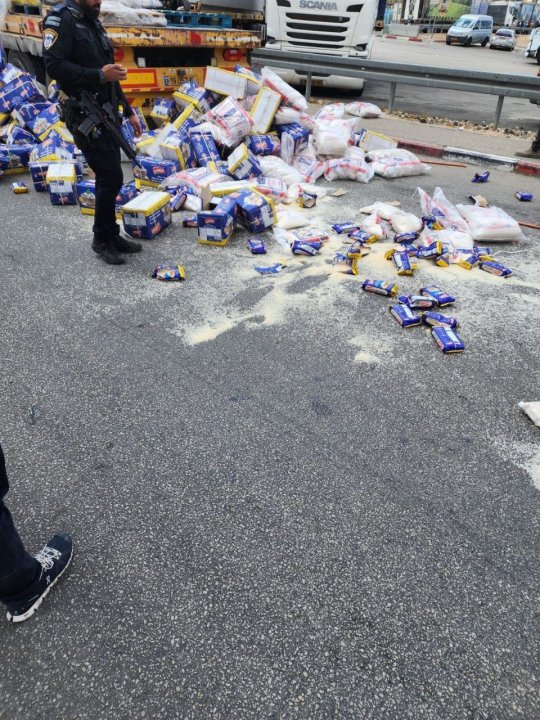
Zionist settlers attack humanitarian aid trucks again and destroy the packages of rice and flour that were going to be distributed among the hungry population of the Gaza Strip.
Gaza is suffering the greatest famine of this century and this is what the supremacists of "Israel" are dedicated to.
#free palestine#free gaza#gaza#palestine#palestine genocide#genocide#famine#war on children#israel#israel is a terrorist state#israel is committing genocide#israel is an apartheid state#israel is a war criminal#israel palestine conflict#anti zionisim#israhell#gaza strip#aid trucks#aid#humanitarian aid#humanitarian crisis#flour#trucks
446 notes
·
View notes
Text
The Flour Massacre was a genocidal act in and of itself. It has already become a notorious event amongst a whole campaign of human rights abuse after human rights abuse. It will be remembered in history like Wounded Knee, My Lai, and Srebrenica. Anyone in denial of that fact can not be helped. Nothing will get through to them. What horror could possibly stir them from complacency?
#the flour massacre#gazan genocide#gaza genocide#free palestine#palestine#israel palestine#war crimes
545 notes
·
View notes
Text
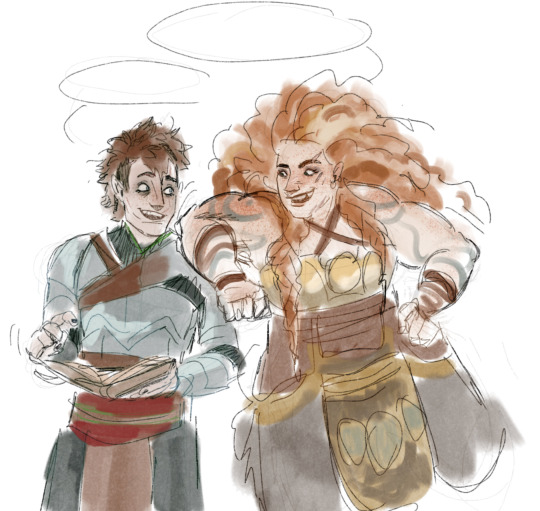
sideblog ragnarok posting
#god of war#gow#god of war ragnorak#god of war ragnarök#gow ragnarok#gow atreus#atreus#loki#gow thrud#thrud#thrúd#my art#every buff jock lesbian needs their nerd best friend they can throw like a sack of flour
801 notes
·
View notes
Text
Cookie Run AU Ideas #7: Operation Abundance

AU where Shadow Milk possesses Golden Cheese!
Burning Spice's body ended up really injured just before they were sealed away, and Shadow Milk saw it. Without the complete souljam, he wasn't sure if Burning Spice would recover completely.
So, the moment the seal opened, he left for the Light of Abundance. Now to deliver it back to Beastyeast! On foot! Without a map because apparently, his host is incredibly recognisable! He definitely remembers the way he took on the way over, just wait a bit longer Burning Spice!
#fyp#cookie run kingdom#cookie run#crk#cr kingdom#shadow milk cookie#vanillaverse#golden cheese cookie#golden cheese is busy sleeping#dreaming of fake illusions#better days before the dark flour war#Nevermore'sMusings
390 notes
·
View notes
Text
Gazan Expresses Joy After Receiving Bread
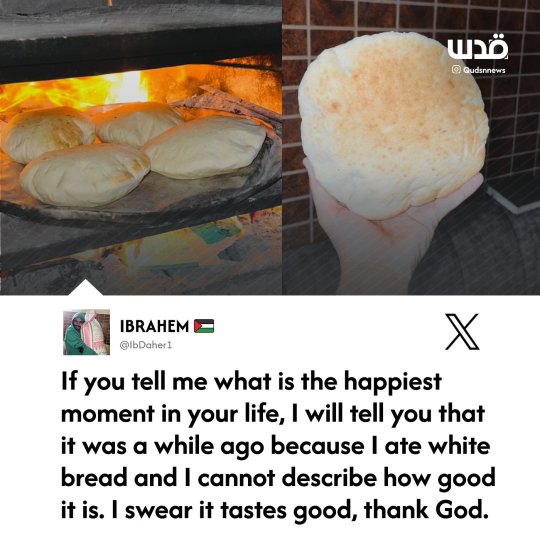
A Palestinian from northern Gaza expresses his joy getting white bread for the first time in five months amid the ongoing Israeli war of starvation on the region.
. Source: Quds News Network
#gaza#palestinians#free palestine#palestine#islamophobia#islam#photography#israel#free gaza#gaza strip#gaza genocide#gazaunderattack#palestine genocide#flour massacre#gaza under attack#gaza war#gaza news#fear and hunger#hunger crisis#conflict#food insecurity#food aid#destruction#united nations#Siege warfare#gazan genocide#gaza now#gazan families#gazanation#unwra
246 notes
·
View notes
Text

they definitely met / had shenanigans before pv was chosen to be an ancient bc fate just kinda works like that sometimes
#there are more#like pv making sm feel the most validated he has ever felt since before the corruption#and sm being his very first friend has so much potential!!!#also sm encouraged pv to commit crimes but in the most manipulative way possible. change my mind#pv summoning “dark moon magic” in the final battle of the dark flour war…. oh pls. sm ABSOLUTELY taught him that.#ppl have been comparing pureshadow to billford lately and honestly yes I can totally see it.#that being said pv WOULD let sm possess him whenever he wants and white lily WOULD be the mcgucket. she even lost her memories it’s canon#and a lot of pv’s questionable choices can be backed up by the fact that#he has literally been turning to a silly lil demon jester god for advice this whole time#I could make one comic trip for each of these tags#cookie run#crk#crk fanart#my art#pure vanilla cookie#shadow milk cookie#pureshadow#beast yeast#cookie run kingdom
60 notes
·
View notes
Text
Remember the first Flour Massacre? Well, CNN has finally dropped the official Israeli story to give you an investigation that basically repeats what Palestinians have been saying all along


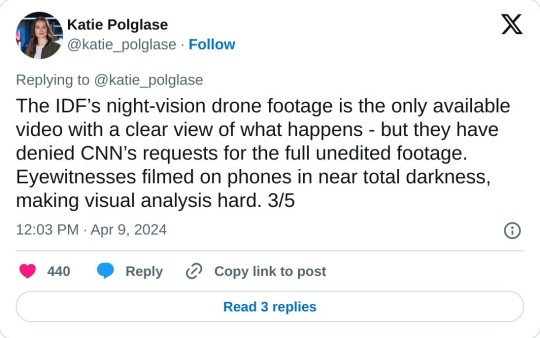


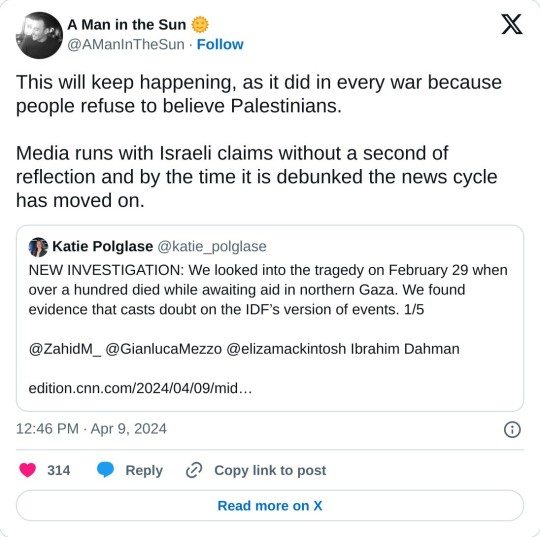
#yemen#jerusalem#tel aviv#current events#palestine#free palestine#gaza#free gaza#news on gaza#palestine news#news update#war news#war on gaza#flour massacre#gaza genocide#media bias#manufactured consent#genocide#famine
17K notes
·
View notes
Text
The flour massacre. 145 days in. All they wanted was food after starving for months.
Source: aljazeeraenglish
#The flour massacre#gaza#فلسطين#all eyes on rafah#palestine#free palestine#jerusalem#free gaza#israeli war crimes#israel#israel is a war criminal#israel is committing genocide#israel is a terrorist state#i stand with palestine
509 notes
·
View notes
Text
Israeli troops fired on a large crowd of Palestinians racing to pull food off an aid convoy in Gaza City on Thursday, witnesses said. More than 100 people were killed in the chaos, which has since been termed the "flour massacre."
This brutal attack has rightly drawn condemnation from many quarters, including from protestors in Tel Aviv, who held up flour bags with red paint on them in protest against the massacre.
(Edited to remove a couple lines that expressed a conclusion I'd jumped to too hastily, which has since been corrected.)
#Palestine#Free Palestine#Gaza#Gaza genocide#Israel Palestine conflict#Israel Palestine war#Israel#collective punishment#Netanyahu is a war criminal#IDF war crimes#flour massacre#tw death#death tw
220 notes
·
View notes
Text
AAA, pure vanilla angst goes brrrr
anyways, my take on how the dark flour war ended! Everyone lived except from pure vanilla and dark enchantress! Don't ask me how PV became healer cookie, I do not know XD
Still on stage 5 on the normal map, but I am HOOKED!
#pure vanilla cookie#dark cocao cookie#hollyberry cookie#hollyberry crk#golden cheese cookie#polyancients#implied a little#closing eyes of a dead person#or rather#cookie#cookie run#crk fanart#krita animation#animation#storyboard#sketch#angst with a sad ending#main character death#he fucking died#blind pure vanilla cookie#dark enchantress cookie#white lily cookie#white lily crk#pure vanilla crk#pure vanilla fanart#dark flour war#soul jam#tw blood#cookie blood
78 notes
·
View notes